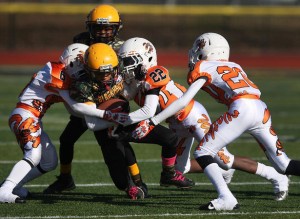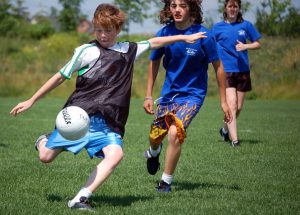 Last week Mary and I spent a few minutes in the hot sun walking our dog. We were less than a block from out front door when one of our neighbors drove by. When he saw us he stopped, opened his window, and we traded social niceties. Then he said, “I’ll only keep you a minute because I know how hot it is, but, yesterday I took my seventh grader to football practice in the middle of the afternoon. It was hotter than it is today. During practice he felt dizzy, had blurry vision, and had to sit down on the field. Fortunately, I was at practice. He motioned for me to come. I hated to walk on the field during practice, but he is my son, and I could see he was distressed. I ran to him; he told me he was too weak to stand up and asked for water. I had to run off the field to find water as players were not allowed to have it with them on the field. I gave him a drink, poured some water on his head and chest and had him lie down. He soon felt strong enough to let me guide him to the car and take him home.
Last week Mary and I spent a few minutes in the hot sun walking our dog. We were less than a block from out front door when one of our neighbors drove by. When he saw us he stopped, opened his window, and we traded social niceties. Then he said, “I’ll only keep you a minute because I know how hot it is, but, yesterday I took my seventh grader to football practice in the middle of the afternoon. It was hotter than it is today. During practice he felt dizzy, had blurry vision, and had to sit down on the field. Fortunately, I was at practice. He motioned for me to come. I hated to walk on the field during practice, but he is my son, and I could see he was distressed. I ran to him; he told me he was too weak to stand up and asked for water. I had to run off the field to find water as players were not allowed to have it with them on the field. I gave him a drink, poured some water on his head and chest and had him lie down. He soon felt strong enough to let me guide him to the car and take him home.
“My question is, shouldn’t they have water on the field? He says they have a break during the middle of practice and they can drink water then and after practice.”
All I could say was, “Oh, my, I’m so sorry, but sure glad you were there.”
We talked and I explained the following to him.
“For many years as a high school team physician, I told the boys and the coaches, that they should each take a one gallon empty, clean milk jug, write their name on it and at bed time fill it 3/4 full with water and put it in the freezer. By morning it will be a solid block of ice. They should add enough water to fill the bottle and take it with them to practice field. And set a goal to drink it all before the end of the practice session.”
“And,” my wife added, “They should have practice early in the morning before the sun gets so hot!”
“Great point!” I replied.
We talked a bit, Neighbor said he would do just that. I encouraged him to talk to the coach, too, because several kids and other athletes die every year from heat stroke. Denying them water won’t make them tougher, but it could make them mighty sick or even worse!
I didn’t get a chance to tell him that i asked the coaches to make a before and after practice weight chart and have the players weigh before and after practice dressed only in their underwear. Active kids can lose a lot of water weight during practice and suffer heat exhaustion and heat stroke.
I emphasized that it is important to weigh as close to naked as possible because sweat saturated clothes will add to their after practice weight. And don’t think that part or most of that weight loss is fat. A 140 # kid needs to run about 35 miles to lose a pound of fat and no coach can push his players that far in a 2-3 hour practice. It takes well-conditioned athletes an average pf 4 ½ hours to run a marathon, and that’s 26.2 miles. If a player is overweight he should attempt to lose no more than 1# weekly. If he feels he has lost weight, he can adjust his base weight 1# a week.
The reason I’m so interested in before and after practice weighing, is that a player can easily lose 4-6 pounds in one practice. In 24 hours, natural thirst instinct will only replace 70% of what is lost. So if a kid loses 4 pounds with each practice and only replaces 3, he will be down about 8 pounds by the end of the fifth day of practice.
A loss of 3% of body weight will give a player the symptom our neighbor boy had (heat stress), 6% will lead to heat exhaustion, and a loss of 9% puts the player in great danger of a heat stroke, which can be fatal. Either of these last two require immediate attention. The victims should be placed in a cool place and if conscious, given lots of water, (never force a semi-conscience person to drink). If the player is unconscious they have heat stroke and 911 must be call immediately while coaches and by-standers drench the player with cold water and ice.
 A big difference between heat exhaustion and heat stroke is a person with heat exhaustion has perfuse sweating and cold, clammy, wet skin. A heat stroke victim is no longer able to sweat and will have hot dry skin and a temperature of 106 or greater. If your child’s sorts program doesn’t provide weight loss charts, you and your kid can do it yourself. Together you can save their life!
A big difference between heat exhaustion and heat stroke is a person with heat exhaustion has perfuse sweating and cold, clammy, wet skin. A heat stroke victim is no longer able to sweat and will have hot dry skin and a temperature of 106 or greater. If your child’s sorts program doesn’t provide weight loss charts, you and your kid can do it yourself. Together you can save their life!
Heat injury is a very scary thing for players, parents, and coaches to see or even to read about but the good news is heat injury is preventable. Not only is pre and post exercise weight important, but a player should be taught he may not return to practice any day his pre weight is down more than a pound from what it was before his first practice.
A very easy way to check your hydration level is to look at the color of your urine. Urine should be the color of clear water or at least lighter than apple juice. Dark urine is a sign of dehydration. I used to tell kids their urine should be the color of Sprite, not Coke, but it shouldn’t taste like either. Laughter is good for all of us!
Sometimes a coach or other adult will recommend salt tablets before practice. Actually, that will make matters worse. It’s not salt that is lacking, it’s water and salt increases the need for water. However, if during the first weeks of hot weather practice a person who is unconditioned loses more than 5 # the first day, he might consider putting some salt on his food that evening and probably every evening that week. But, more importantly, he must regain that weight before hitting the practice field again. Our genius bodies learn to secrete less salt in our sweat as we become conditioned. So after the first two weeks additional salt is not needed.
There are some other risks for heat injury:
Fat in overweight people insulates the body and keeps the heat in. Obese people often complain of being too hot; they should be especially alert to drinking water while exercising.
Kids who live, work, study, exercise, and whose schools are conditioned are also at increased risk.
And, it’s well to remember that it’s not only the temperature, but the humidity as well. All coaches have access to charts of temperature and humidity telling when full practice is ok, when it should be modified, and when it should not be permitted. You can find a link to the chart below taken from my sports medicine book, Sports Doc. The book was published in 1975, but it still applies today. Feel free to copy it and share it with other players and their coaches. https://parentingwithdrpar.com/wp-content/uploads/2020/07/Heat-exercise-chart-2020-07-20_144656-Shortcut.lnk_.pdf
Enjoy what’s left of the summer and stay healthy and safe.

Hey Par; Should these kids be avoiding close contact exposure in mist of Covid epidemic? Mike Mally M.D.
Thanks, Mike, that’s a good point. It’s one the Tennessee Secondary Schools athletic association have studied and are regulating. I choose to limit my remarks to the danger of playing in the heat.
This important post should be read by coaches and parents alike. I will share it on my social media sites.